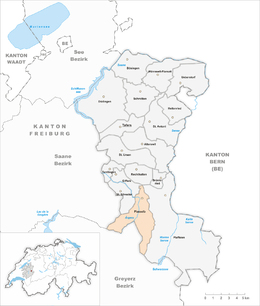Plasselb
| Plasselb | ||
|---|---|---|

Plasselb village
|
||
|
||
| Coordinates: 46°44′N 7°15′E / 46.733°N 7.250°ECoordinates: 46°44′N 7°15′E / 46.733°N 7.250°E | ||
| Country | Switzerland | |
| Canton | Fribourg | |
| District | Sense | |
| Government | ||
| • Mayor | Gemeindeammann | |
| Area | ||
| • Total | 18.12 km2 (7.00 sq mi) | |
| Elevation | 856 m (2,808 ft) | |
| Population (Dec 2015) | ||
| • Total | 1,021 | |
| • Density | 56/km2 (150/sq mi) | |
| Postal code | 1737 | |
| SFOS number | 2300 | |
| Surrounded by | Cerniat, Giffers, La Roche, Le Mouret, Oberschrot, Plaffeien, Sankt Silvester | |
| Website |
www SFSO statistics |
|
Plasselb is a municipality in the district of Sense in the canton of Fribourg in Switzerland. It is one of the municipalities with a large majority of German speakers in the mostly French speaking Canton of Fribourg.
Plasselb is first mentioned in 1324 as Plannaseyva.
Plasselb has an area of 18.12 km2 (7.00 sq mi). Of this area, 6.73 km2 (2.60 sq mi) or 37.1% is used for agricultural purposes, while 10.06 km2 (3.88 sq mi) or 55.5% is forested. Of the rest of the land, 0.73 km2 (0.28 sq mi) or 4.0% is settled (buildings or roads), 0.2 km2 (0.077 sq mi) or 1.1% is either rivers or lakes and 0.39 km2 (0.15 sq mi) or 2.2% is unproductive land.
Of the built up area, housing and buildings made up 2.0% and transportation infrastructure made up 1.6%. Out of the forested land, 51.9% of the total land area is heavily forested and 3.6% is covered with orchards or small clusters of trees. Of the agricultural land, 9.6% is pastures and 27.2% is used for alpine pastures. All the water in the municipality is flowing water.
The municipality is located in the Sense district, at the foot of the Schweinsberg at the entrance to the Plasselbschlund. It consists of the village of Plasselb and, since 1971, Neuhaus.
The blazon of the municipal coat of arms is Sable a Bar Argent and overall a Deer salient Or.
Plasselb has a population (as of December 2015[update]) of 1,021. As of 2008[update], 7.7% of the population are resident foreign nationals. Over the last 10 years (2000–2010) the population has changed at a rate of -3.2%. Migration accounted for -5.2%, while births and deaths accounted for 0.7%.
Most of the population (as of 2000[update]) speaks German (913 or 93.2%) as their first language, French is the second most common (22 or 2.2%) and Albanian is the third (21 or 2.1%). There are 2 people who speak Italian.
...
Wikipedia



